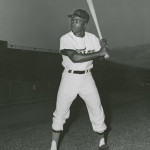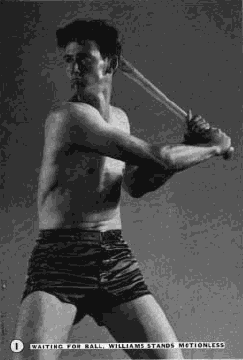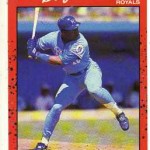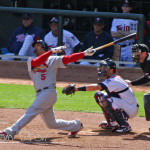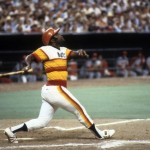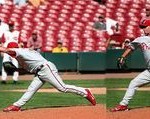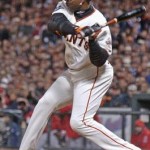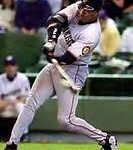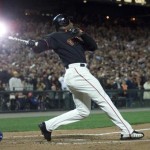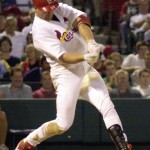
(This article and the one following will elaborate on my previous 5 Posts)
Most elementary Science teachers will begin their instruction on the study of inertia with the application of its principle along with a frame of reference relative to the Newtonian laws of motion. Simply stated, inertia is the tendency of a body at rest, or in motion, to remain in that state unless acted upon by an external force. The common imagery used by teachers is that of a bus colliding head-on with an immovable object. If the bus is travelling at a speed of 100 MPH, and the object hit is truly immoveable, then the entire contents (unless securely fastened) at the back of the bus will explode forward at the speed of 100 MPH. Newton’s third law of motion helps to enhance the imagery by understanding that, “every action has an opposite and equal reaction.”
The principles governing the aforementioned laws have their applications in various aspects of our National Pastime. A casual observer would be hard pressed to notice the specific application of Physics in correlation to the areas of fielding and running, although we all know they are there. But with regard to batting and throwing, everyone has at least an inkling of an understanding that proper mechanical application of the subtle laws of physics has afforded certain individuals uncommon advantage over their less astute peers.
There are many facets to consider when establishing the proper mechanics for batting and throwing, but this essay will consider only how the “inertial principle” is applied, relative to the size and strength of individuals throwing and hitting a baseball. The forward movements of the bus and the body are not identical, but their accommodation to the Physics principle is similar enough to be of practical import. To be remembered is the additional fact that if the object struck by the bus is not totally immoveable, the degree to which the impact is defused will determine the actual speed of the objects thrown forward inside the bus ( if not securely fastened).
Newton’s equation, F=ma, is described as, the Force unleashed is equal to the mass (size, weight, and strength) times the speed of acceleration of the moving object. Therefore a bus and a motor-cycle hitting an immoveable object will not have the same force of impact. However, a rider on a motor-cycle and a rider on top of a bus, each travelling at a speed of 100 MPH, and each having a baseball in hand, toss the balls forward at 5 MPH. Both balls would travel at a speed 105 MPH.
So, how does a human-body generate the amount of force that is equal to the body’s mass times acceleration (F=ma) to throw and hit a baseball with maximum power?
The instant before the front leg is completely straightened, the upper body is arched back and squared to the target while the throwing shoulder and arm are prepared to launch the ball. At that point, the front foot and leg exert their final burst of power, sending the backward arched torso into an explosive forward tumbling action which in turn catapults the outwardly rotated shoulder and corresponding bent arm to deliver the pitched ball with maximum force. If the entire throwing apparatus is precise, and throwing “mechanics” are applied correctly, but the front foot plant is not presented as “immoveable,” but gives way, then the amount of Force to be generated is compromised and cannot attain “maximum” utility.
While the front leg is in the process of straightening, the second phase of power has begun with the twisting-torque action of the “Oblique” core-group of muscles as well the entire lower torso. As the shoulders and upper torso are concluding the swing and the bat is ready to contact the ball, the front leg has completely straightened, providing that “immoveable” barrier from which the entire back-side has provided maximum force with which the bat can make contact with the ball.
The front foot secures the ground with such force from the straightening front leg that the front hip is being forced open as the back hip is driven forward with equipollence by the aid of a forward driving back bent-knee. If performed properly, the vertical axis of spine and upper body remains constant while the hips are rotating along a consistent horizontal plane. The angle formed, by a diagonal front leg and an upper body and head, as the swing is commencing and concluding is usually not less than 180 degrees.
The “turnstile” action of the batter’s swing allows the vertical axis of the body to remain intact, which facilitates the least amount of head movement. The less head movement, the better the batter can detect the nuances of the speeding ball!
A 450-foot drive, off a well-attuned swing from Mark McGwire, or any good power-hitter, gives reason to applaud a magnificent stroke. But, how is it that they sometimes hit a prodigious “shot” of 500 feet or more? When you really live up to that favorite expression of batters, “I got it all,” your bat made contact with the ball while the body was turning through the swing with the vertical axis intact! The centripetal force provided by the stable position of the vertical axis produces the powerful centrifugal force, which magnifies the power elicited by the turning hips and shoulders. All of this is predicated on the “front-foot plant” that provides the “immoveable wall” from which all the power is transferred from the “back of the Bus.”
Anecdotal Notes:
1. The Best, and most consistent, means for applying the “front foot plant” is for the batter to refrain from taking a stride. Simply, but forcefully, apply quick and powerful pressure to the front foot and leg to initiate the swing – Least margin for error.
2. Those batters who incorrectly assume that they need a stride, or high knee kick to initiate their swings will unwittingly compromise the proficiency of their foot plants when good pitchers easily offset their timing with off-speed pitches – greater margin for error.
